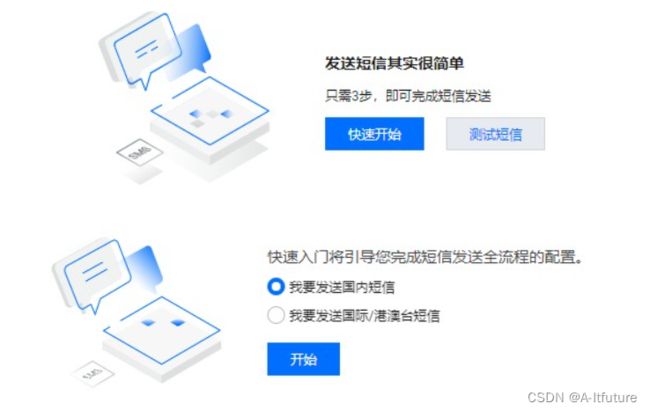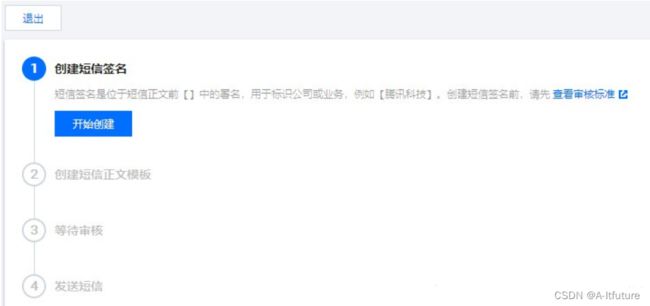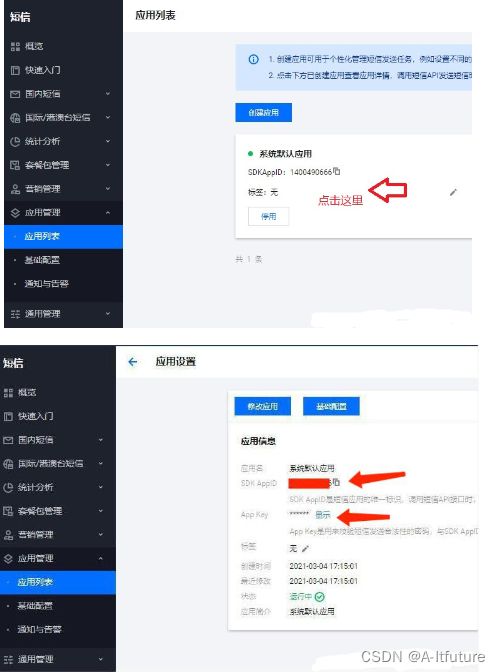【短信发送】实现腾讯云发送短信功能--工具类和SpringBoot配置两种方法实现
实现腾讯云发送短信功能--工具类和SpringBoot配置两种方法实现
- 一、开通腾讯云短信服务
- 二、工具类--使用qcloudsms实现短信发送
- 三、Spring Boot项目引入短信发送功能
我们发现,大多数系统的登陆验证以及数据安全都以手机号为主,因此,许多的系统都采用绑定手机号或者手机号验证的类似功能,因此,本篇介绍并提供短信发送功能的实现内容。
一、开通腾讯云短信服务
1.通过个人微信公众号申请开通短信服务,首次开通可以免费获赠100条国内短信。

微信公众平台:https://mp.weixin.qq.com,先要注册个人订阅号。
2.然后登录腾讯云,在界面的右上角点击控制台进入,鼠标移到左上角的云产品,搜索短信进入短信模块,申请开通,点击开始接入。

5.这里签名用途选择自用,签名类型选公众号,签名内容写你的公众号名称,证明类型选公众号设置页面截图,可以查看范例,截图上传,申请说明写公众号全称。
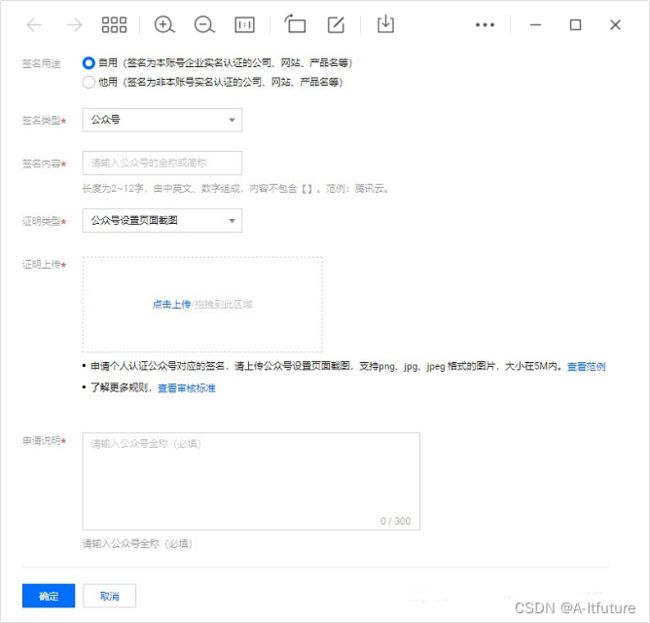
6.等待十几分钟后,签名通过,就可以创建正文模板了。记下签名的内容,后面发送短信要用到(配置yml的时候用)。
7.创建正文模板,这里的短信内容里的{1}和{2}是占位符,需要通过参数传过去。
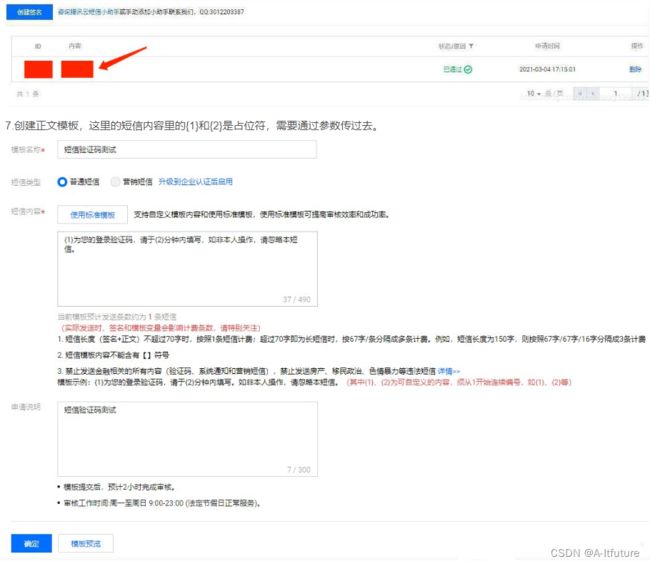
8.等待十几分钟后,正文模板审核通过。记下正文模板的ID,后面发送短信要用到(配置yml的时候用)。
9.最后再到应用管理中的应用列表,拿到你的SDK AppID和App Key(配置yml的时候用),就可以测试发送短信了。
二、工具类–使用qcloudsms实现短信发送
首先提供工具类的方式去实现短信发送功能。
需要的依赖包是com.github.qcloudsms下的qcloudsms。
具体如下(里面的应用ID、key、模板id都是自已在开通云服务时设置好的,填自己的就行):
import com.alibaba.fastjson.JSONException;
import com.github.qcloudsms.SmsSingleSender;
import com.github.qcloudsms.SmsSingleSenderResult;
import com.github.qcloudsms.httpclient.HTTPException;
import java.io.IOException;
/**自定义发送短信的工具类 (项目不用该类,使用sprinboot自动配置类)
* @Description:
* @Author wxh
* @Version 1.0
* @Date Created in 2021-01-03 13:05
*/
public class SMSUtil {
// 短信应用 SDK AppID
private static int appid = 14002568; // SDK AppID 以1400开头
// 短信应用 SDK AppKey
private static String appkey = "应用App Key";
// 需要发送短信的手机号码
// String[] phoneNumbers = {"13025468745","145827485"};
// 短信模板 ID,需要在短信应用中申请
private static int templateId1 = 1264448; // NOTE: 这里的模板 ID`7839`只是示例,真实的模板 ID 需要在短信控制台中申请
private static int templateId2 = 1265837; // NOTE: 这里的模板 ID`7839`只是示例,真实的模板 ID 需要在短信控制台中申请
// 签名
private static String smsSign = "Itfuture栈"; // NOTE: 签名参数使用的是`签名内容`,而不是`签名ID`。这里的签名"腾讯云"只是示例,真实的签名需要在短信控制台申请
public static boolean QCloudSmsSend(String phoneNumber,String code){
try {
String[] params = new String[1];
params[0] =code;
SmsSingleSender ssender = new SmsSingleSender(appid, appkey);
//sendWithParm: 传入国家码 电话号码 模板id 模板参数 签名 扩展码为空 返回参数为空
SmsSingleSenderResult result = ssender.sendWithParam("86", phoneNumber,
templateId1, params, smsSign, "", "");
if(result.result==0){
return true;
}else{
System.out.println("短信发送失败,原因:"+result.errMsg);
}
} catch (HTTPException e) {
// HTTP 响应码错误
e.printStackTrace();
} catch (JSONException e) {
// JSON 解析错误
e.printStackTrace();
} catch (IOException e) {
// 网络 IO 错误
e.printStackTrace();
}
return false;
}
public static boolean loginSmsSend(String phoneNumber,String code){
try {
String[] params = new String[1];
params[0] =code;
SmsSingleSender ssender = new SmsSingleSender(appid, appkey);
//sendWithParm: 传入国家码 电话号码 模板id 模板参数 签名 扩展码为空 返回参数为空
SmsSingleSenderResult result = ssender.sendWithParam("86", phoneNumber,
templateId2, params, smsSign, "", "");
if(result.result==0){
return true;
}else{
System.out.println("短信发送失败,原因:"+result.errMsg);
}
} catch (HTTPException e) {
// HTTP 响应码错误
e.printStackTrace();
} catch (JSONException e) {
// JSON 解析错误
e.printStackTrace();
} catch (IOException e) {
// 网络 IO 错误
e.printStackTrace();
}
return false;
}
}
三、Spring Boot项目引入短信发送功能
接下来主要是如何在spring boot项目使用该功能
1.在项目代码的commons层导入依赖;
<dependency>
<groupId>com.github.qcloudsms</groupId>
<artifactId>qcloudsms</artifactId>
<version>1.0.6</version>
</dependency>
2.application.yml参数设置,放在项目名称下。
# 短信发送参数
txsms:
AppId: 1400616 # 你的系统默认应用SDK AppID
AppKey: "应用App Key" # 你的系统默认应用App Key
TemplateId1: 12648 # 你的正文模板ID1
TemplateId2: 12637 # 你的正文模板ID2
signName: "Itfuture栈" # 你的签名内容
3.SpringBoot自动装配(springboot最大特点)
/**
* 自动配置类
* 配置工具类 template
*/
@Configuration
@EnableConfigurationProperties({TxProperties.class})
public class CommonsAutoConfiguration {
/*
* 创建发送短信的工具类
* 将TxProperties对象注入到容器中
* 要配置CommonsAutoConfiguration到resources/META-INF/spring.factories中
* */
@Bean
public TxSmsTemplate txSmsTemplate(TxProperties txProperties) {
return new TxSmsTemplate(txProperties);
}
}
4.创建参数配置类TxProperties.java
/**腾讯云发送短信
* 参数配置类
* @author: wxh
* @version:v1.0
* @date: 2022/11/11 21:12
*/
@Data
// 读取application.yml中的项目名称.txsms的属性
@ConfigurationProperties("e.txsms")
public class TxProperties {
// AppId 1400开头的
private int AppId;
// 短信应用SDK AppKey
private String AppKey;
// 短信模板ID1
private int TemplateId1;
// 短信模板ID2
private int TemplateId2;
// 签名
private String signName;
}
5.创建TxSmsTemplate.java
模板里面主要定义自己所需要的业务功能(即不同模板可以实现不同功能),比如:我定义了两个模板,一个实现发送取件码功能,一个实现登陆注册验证功能。
package com.itfuture.e.sms;
import com.alibaba.fastjson.JSONException;
import com.github.qcloudsms.SmsSingleSender;
import com.github.qcloudsms.SmsSingleSenderResult;
import com.github.qcloudsms.httpclient.HTTPException;
import lombok.extern.slf4j.Slf4j;
import org.springframework.stereotype.Component;
import java.io.IOException;
/**腾讯云发送短信模板对象,封装了发送短信的api
* @author: wxh
* @version:v1.0
* @date: 2022/11/11 21:15
*/
@Slf4j
@Component
public class TxSmsTemplate {
private TxProperties txProperties;
public TxSmsTemplate(TxProperties txProperties) {
this.txProperties = txProperties;
}
/**
* 发送取件码
* @param phoneNumber 手机号
* @param code 取件码
* @return
*/
public boolean sendMsgCode(String phoneNumber,String code) {
try {
// 接收生成的验证码,设置5分钟内填写
String[] params = {code, "5"};
// 构建短信发送器
SmsSingleSender ssender = new SmsSingleSender(txProperties.getAppId(), txProperties.getAppKey());
//sendWithParm: 传入国家码 电话号码 模板id 模板参数 签名 扩展码为空 返回参数为空
SmsSingleSenderResult result = ssender.sendWithParam("86", phoneNumber,
txProperties.getTemplateId1(), params, txProperties.getSignName(), "", ""); // 签名参数未提供或者为空时,会使用默认签名发送短信
if(result.result==0){
return true;
}else{
System.out.println("短信发送失败,原因:"+result.errMsg);
}
} catch (HTTPException e) {
// HTTP响应码错误
log.info("短信发送失败,HTTP响应码错误!");
// e.printStackTrace();
} catch (JSONException e) {
// json解析错误
log.info("短信发送失败,json解析错误!");
//e.printStackTrace();
} catch (IOException e) {
// 网络IO错误
log.info("短信发送失败,网络IO错误!");
// e.printStackTrace();
}
return false;
}
/**
* 登陆、注册验证
* @param phoneNumber 手机号
* @param code 验证码
* @return
*/
public boolean loginSmsSend(String phoneNumber,String code){
try {
// 接收生成的验证码,设置5分钟内填写
String[] params = {code, "5"};
// 构建短信发送器
SmsSingleSender ssender = new SmsSingleSender(txProperties.getAppId(), txProperties.getAppKey());
//sendWithParm: 传入国家码 电话号码 模板id 模板参数 签名 扩展码为空 返回参数为空
SmsSingleSenderResult result = ssender.sendWithParam("86", phoneNumber,
txProperties.getTemplateId2(), params, txProperties.getSignName(), "", ""); // 签名参数未提供或者为空时,会使用默认签名发送短信
if(result.result==0){
return true;
}else{
System.out.println("短信发送失败,原因:"+result.errMsg);
}
} catch (HTTPException e) {
// HTTP响应码错误
log.info("短信发送失败,HTTP响应码错误!");
// e.printStackTrace();
} catch (JSONException e) {
// json解析错误
log.info("短信发送失败,json解析错误!");
//e.printStackTrace();
} catch (IOException e) {
// 网络IO错误
log.info("短信发送失败,网络IO错误!");
// e.printStackTrace();
}
return false;
}
}
6.测试
@RunWith(SpringRunner.class)
@SpringBootTest
public class TestSms {
@Autowired
private TxSmsTemplate txSmsTemplate;
/**
* 腾讯云发送短信测试
*/
@Test
public void TxSmsTest(){
// 参数1: 手机号(正文模板中的参数{1})
// 参数2: 验证码(正文模板中的参数{2})
boolean Msg = txSmsTemplate.sendMsgCode("用户手机号码", "验证码");
System.out.println(Msg);
}
}
声明:本文中所有的AppId以及AppKey都是假的,只是为了更加真实,便于理解。
